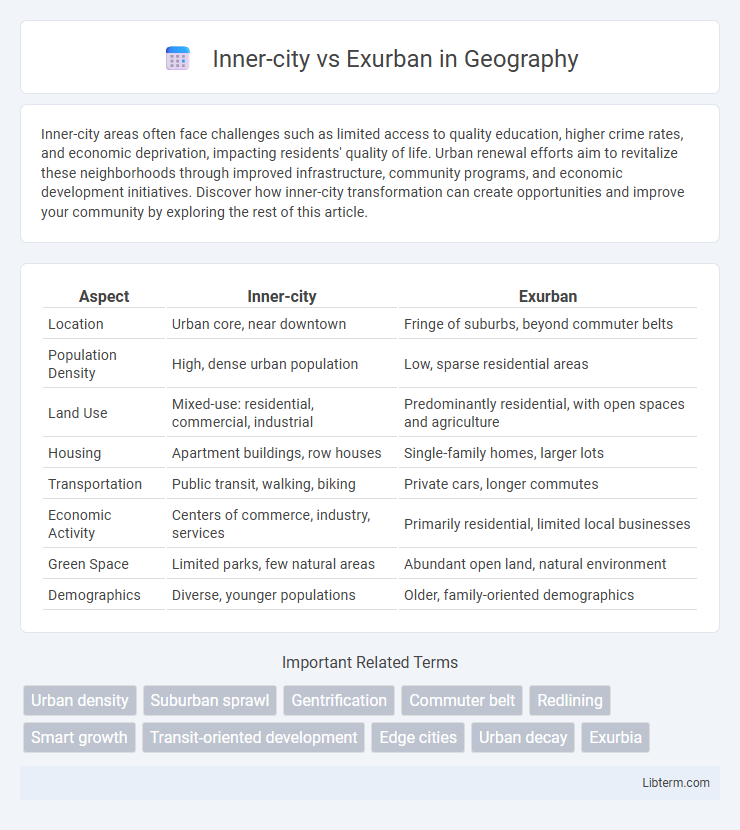Inner-city areas often face challenges such as limited access to quality education, higher crime rates, and economic deprivation, impacting residents' quality of life. Urban renewal efforts aim to revitalize these neighborhoods through improved infrastructure, community programs, and economic development initiatives. Discover how inner-city transformation can create opportunities and improve your community by exploring the rest of this article.
Table of Comparison
| Aspect | Inner-city | Exurban |
|---|---|---|
| Location | Urban core, near downtown | Fringe of suburbs, beyond commuter belts |
| Population Density | High, dense urban population | Low, sparse residential areas |
| Land Use | Mixed-use: residential, commercial, industrial | Predominantly residential, with open spaces and agriculture |
| Housing | Apartment buildings, row houses | Single-family homes, larger lots |
| Transportation | Public transit, walking, biking | Private cars, longer commutes |
| Economic Activity | Centers of commerce, industry, services | Primarily residential, limited local businesses |
| Green Space | Limited parks, few natural areas | Abundant open land, natural environment |
| Demographics | Diverse, younger populations | Older, family-oriented demographics |
Defining Inner-City and Exurban Areas
Inner-city areas are densely populated urban neighborhoods characterized by older infrastructure, higher population density, and often lower socioeconomic status compared to suburban or exurban regions. Exurban areas lie beyond the suburbs, featuring lower population density, more open space, and a mix of rural and residential land use, typically attracting residents seeking more affordable housing and a quieter environment. These distinctions reflect differences in urban planning, economic opportunities, and demographic patterns influencing housing, transportation, and community services.
Demographic Differences
Inner-city areas typically feature higher population densities with diverse racial and ethnic compositions, often including a larger proportion of younger adults and lower-income households. Exurban regions generally exhibit lower population densities characterized by predominantly white, higher-income families with greater homeownership rates and older age demographics. These demographic differences influence local economics, schooling systems, and community services, reflecting distinct urban-suburban migration trends and lifestyle preferences.
Economic Opportunities and Employment
Inner-city areas offer concentrated access to diverse job markets, including corporate, retail, and service industries, benefiting from extensive public transportation systems that enhance workforce mobility. Exurban regions, characterized by lower population density and more residential development, often provide limited local employment opportunities, with residents frequently commuting to urban centers for work in sectors like manufacturing, technology, and education. Economic opportunities in inner cities are typically more abundant but competitive, while exurbs present emerging markets with potential for growth in construction, small businesses, and telecommuting professions.
Infrastructure and Transportation
Inner-city areas feature dense infrastructure with extensive public transportation networks including subways, buses, and bike lanes, facilitating easy access and reducing reliance on personal vehicles. Exurban regions often have limited public transit options, leading to higher dependence on automobiles and necessitating well-maintained roadways and highway connections for commuting. Infrastructure in inner cities supports walkability and mixed-use developments, whereas exurban areas prioritize car-centric design and sprawling residential layouts.
Housing and Urban Development
Inner-city areas feature dense housing with a mix of historic buildings and high-rise apartments, often supported by urban redevelopment programs targeting affordable housing and community revitalization. Exurban regions offer larger residential properties with newer construction, reflecting lower-density development policies and expanding suburban infrastructure. Urban development strategies emphasize sustainable growth through improved transit access in inner cities while managing land use and environmental impact in exurban zones.
Education Access and Quality
Inner-city areas often face challenges such as overcrowded classrooms, underfunded schools, and limited access to advanced educational programs, contributing to disparities in education quality. Exurban regions typically benefit from newer schools with better facilities, lower student-to-teacher ratios, and more access to extracurricular activities, enhancing overall educational outcomes. However, transportation barriers and longer commute times in exurban zones can impact student attendance and participation.
Lifestyle and Cultural Amenities
Inner-city living offers vibrant cultural amenities including theaters, museums, diverse dining, and nightlife that foster an active, urban lifestyle. Exurban areas provide spacious homes, natural surroundings, and a quieter, family-oriented lifestyle with limited access to immediate cultural activities. Residents in inner cities benefit from walkability and public transit, while exurban dwellers rely on cars and enjoy outdoor recreational amenities.
Crime Rates and Public Safety
Inner-city areas often experience higher crime rates due to increased population density and socio-economic challenges, impacting public safety and community well-being. Exurban regions typically report lower crime levels, benefiting from more dispersed populations and greater community surveillance, which enhances overall safety. Law enforcement resources and community engagement differ significantly between these environments, influencing crime prevention effectiveness.
Environmental Sustainability
Inner-city areas typically exhibit higher environmental sustainability due to dense infrastructure, promoting reduced energy consumption and greater reliance on public transportation compared to exurban regions. Exurban communities often experience increased carbon emissions linked to longer commutes and greater dependence on personal vehicles. Urban planning that prioritizes mixed-use development and green spaces in inner cities supports biodiversity and minimizes urban sprawl, enhancing overall ecological resilience.
Future Trends and Urban Planning
Future trends in urban planning emphasize sustainable development and smart infrastructure in inner-city areas to accommodate growing populations while reducing environmental impact. Exurban regions are expected to experience increased residential expansion driven by remote work flexibility, necessitating improved transportation networks and digital connectivity. Strategic integration of green spaces and mixed-use developments in both inner-city and exurban zones will be critical to fostering resilient, livable communities.
Inner-city Infographic

 libterm.com
libterm.com